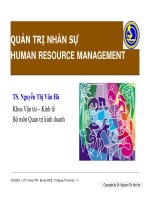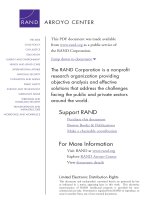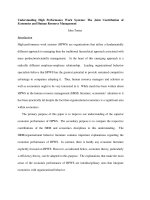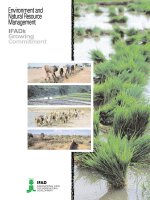HUman resource managemenr 2e s keiman chapter4
Bạn đang xem bản rút gọn của tài liệu. Xem và tải ngay bản đầy đủ của tài liệu tại đây (301.78 KB, 35 trang )
Chapter 4
Analyzing Jobs
Human Resource Management, 2/E, Lawrence S. Kleiman
© 2000 by South-Western College Publishing
4-1
HRM and Competitive Advantage
HR Planning
Job Analysis
Recruitment
Selection
Training/Develop.
Performance App.
Compensation
Productivity Imp.
Competence
Motivation
Work Attitudes
Output
Retention
Legal Compliance
Company Image
Cost
Leadership
Product
Differentiation
Workplace Justice
Unions
Safety & Health
International
Human Resource Management, 2/E, Lawrence S. Kleiman
© 2000 by South-Western College Publishing
4-2
Linking Job Analysis Practices to
Competitive Advantage
Competent, Motivated
Employees With Positive
Job Attitudes
Effective
Job Analysis
Competitive
Advantage
Job-Related
HRM
Minimized HRM-Related
Lawsuits
Human Resource Management, 2/E, Lawrence S. Kleiman
© 2000 by South-Western College Publishing
4-3
Uses of Job Analysis
Training &
Development
Recruitment/
Selection
Performance
Appraisal
Job Analysis
Foundations
Employee
Discipline
Safety & Health
Human Resource Management, 2/E, Lawrence S. Kleiman
© 2000 by South-Western College Publishing
Compensation
Performance
Improvement
Programs
4-4
Job Analysis Decisions
• What type of information will be collected?
• How will the information be collected?
• How will the information be recorded or
documented?
Human Resource Management, 2/E, Lawrence S. Kleiman
© 2000 by South-Western College Publishing
4-5
Job Analysis Information
Job Context
plant assembly
line
Worker
Requirements
knowledge, skills,
abilities
Job Content
assemble boxes
Human Resource Management, 2/E, Lawrence S. Kleiman
© 2000 by South-Western College Publishing
4-6
Job Content Information
• What the worker does
• The purpose of the action
• The tools, equipment, or machinery used
in the process
• Task importance
• Expected performance levels
• Training needed
Human Resource Management, 2/E, Lawrence S. Kleiman
© 2000 by South-Western College Publishing
4-7
Job Context
•
•
•
•
•
•
•
•
Reporting relationships
Supervision received
Judgment
Authority
Personal contacts
Working conditions
Physical demands
Personal demands
Human Resource Management, 2/E, Lawrence S. Kleiman
© 2000 by South-Western College Publishing
4-8
Worker Requirements Information
•
•
•
•
•
Knowledge
Skills
Ability
Personal characteristics
Credentials
Human Resource Management, 2/E, Lawrence S. Kleiman
© 2000 by South-Western College Publishing
4-9
How to Gather Job Information
• Interviews
• Observation
• Questionnaires
Human Resource Management, 2/E, Lawrence S. Kleiman
© 2000 by South-Western College Publishing
4-10
Job Analysis Interview
Human Resource Management, 2/E, Lawrence S. Kleiman
© 2000 by South-Western College Publishing
4-11
Strengths of Job Analysis Interview
• Most frequently used
• Can be used to collect all types of job
analysis information
• The only way to collect some types of job
analysis information
Human Resource Management, 2/E, Lawrence S. Kleiman
© 2000 by South-Western College Publishing
4-12
Weakness of Job Analysis Interview
• Incumbents may inflate their jobs
• May reveal only a superficial view of the job
• Time consuming
Human Resource Management, 2/E, Lawrence S. Kleiman
© 2000 by South-Western College Publishing
4-13
Job Analysis Observation
Human Resource Management, 2/E, Lawrence S. Kleiman
© 2000 by South-Western College Publishing
4-14
Job Analysis Observation Strengths
• Can determine real rather than estimated time spent
on tasks
• Not subject to self-report biases or
misunderstandings
• Can check consistency of results by comparing notes
• Useful for complex jobs
• Useful for identifying subtasks
Human Resource Management, 2/E, Lawrence S. Kleiman
© 2000 by South-Western College Publishing
4-15
Job Analysis Observation Weaknesses
• Irregularly performed tasks are difficult to capture.
• Not all tasks are observable.
• Some workers behave atypically when observed.
Human Resource Management, 2/E, Lawrence S. Kleiman
© 2000 by South-Western College Publishing
4-16
Job Analysis Questionnaires
Human Resource Management, 2/E, Lawrence S. Kleiman
© 2000 by South-Western College Publishing
4-17
Types of Job Analysis Questionnaires
• Job analysis
inventory
• Task inventory
• Ability inventory
Human Resource Management, 2/E, Lawrence S. Kleiman
© 2000 by South-Western College Publishing
4-18
Job Analysis Questionnaires Strengths
• Can get information from several people
simultaneously
• Information can be collected quickly
• Can be used to group jobs
• Can be used to determine workers’ training
needs
Human Resource Management, 2/E, Lawrence S. Kleiman
© 2000 by South-Western College Publishing
4-19
Job Analysis Questionnaires Weaknesses
• Limited applicability
• Bias and self-inflated responses are possible
Human Resource Management, 2/E, Lawrence S. Kleiman
© 2000 by South-Western College Publishing
4-20
Determining How Job Analysis
Information will be Recorded
• Job descriptions---general purpose
• Job descriptions---special purpose
– Ability Requirements Approach
– Position Analysis Questionnaire
– Critical Incident Technique
– Versatile Job Analysis
Human Resource Management, 2/E, Lawrence S. Kleiman
© 2000 by South-Western College Publishing
4-21
General Purpose Job Description
Job Identification
Job Summary
Essential Functions
Job Specifications
Human Resource Management, 2/E, Lawrence S. Kleiman
© 2000 by South-Western College Publishing
4-22
General Purpose Job Descriptions
Strengths
• Vital HRM tool
• Can be used for
many purposes
Human Resource Management, 2/E, Lawrence S. Kleiman
© 2000 by South-Western College Publishing
Weaknesses
• Brief
• Deficient for some
purposes
4-23
VERJAS
• Duties
• Tasks
• Task ratings
– importance
– needed training
• Job context
• Competencies
Human Resource Management, 2/E, Lawrence S. Kleiman
© 2000 by South-Western College Publishing
4-24
Ability Requirements Approach
• Mental abilities
• Perception abilities
• Psychomotor
abilities
• Physical abilities
• Sensory abilities
Human Resource Management, 2/E, Lawrence S. Kleiman
© 2000 by South-Western College Publishing
4-25




![audio engineering 101 [electronic resource] a beginner's guide to music production](https://media.store123doc.com/images/document/14/y/ii/medium_iij1401381447.jpg)
![broken markets [electronic resource] a user's guide to the post-finance economy](https://media.store123doc.com/images/document/14/y/kz/medium_kzd1401381668.jpg)
![ios sdk programming [electronic resource] a beginner's guide](https://media.store123doc.com/images/document/14/y/ph/medium_phw1401472929.jpg)


